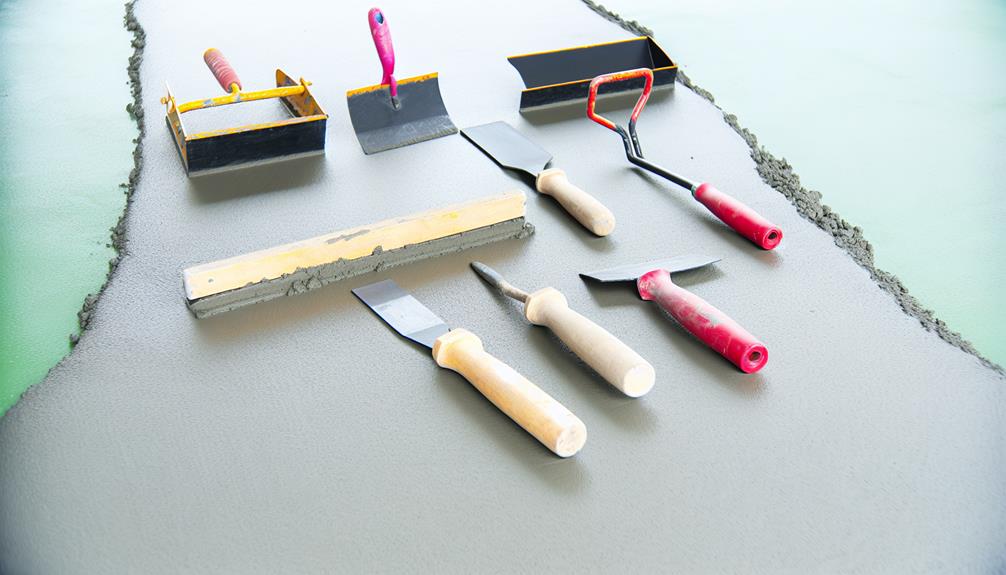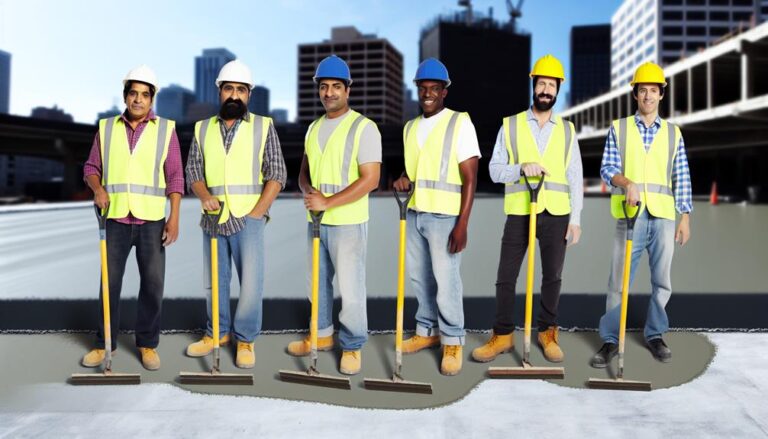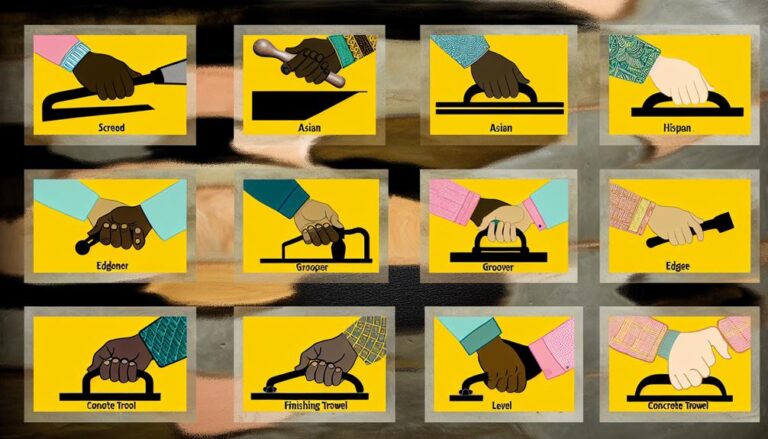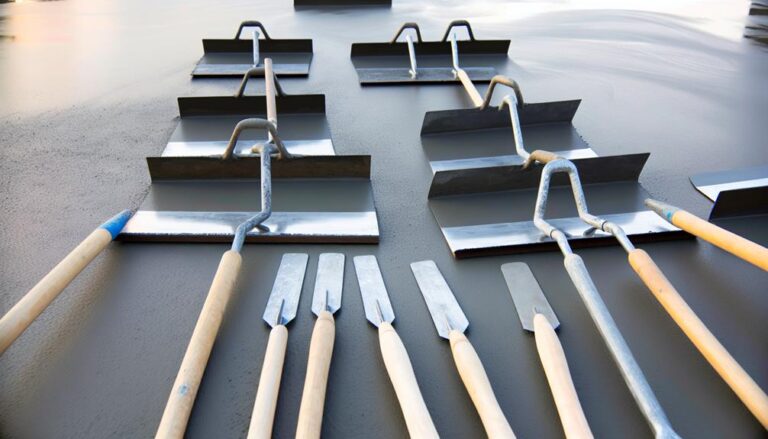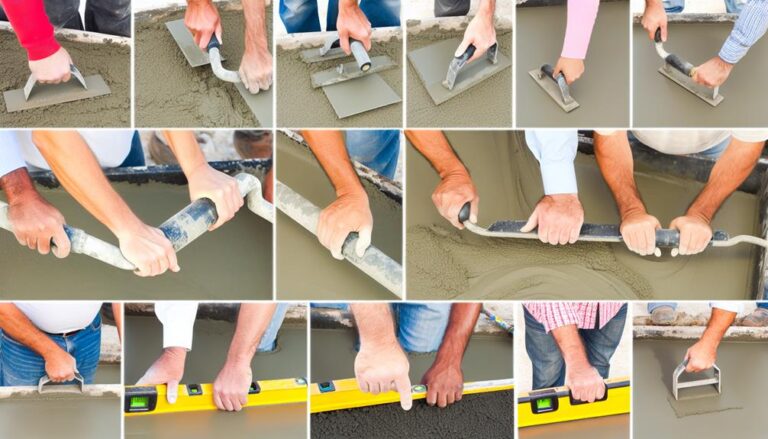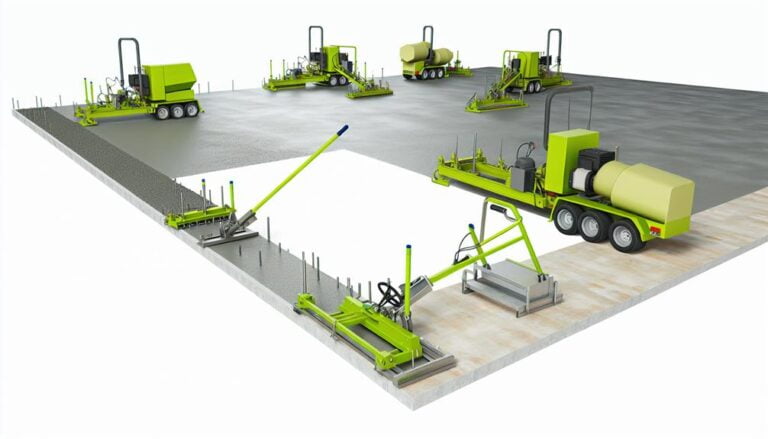How-To Guide: Essential Equipment for Concrete Leveling
To level concrete, you'll need a concrete mixer for consistency, screeds for even distribution, and trowels for smoothing surfaces. Power trowels are beneficial for larger projects. Remember, different project sizes require different tools sizes. Additionally, using the correct equipment is crucial for efficiency, precision, and safety, and will save on labor costs and potential rework. Regular maintenance is essential for proper functioning and longevity of your tools. There's more to this: the choice of equipment depends on your project type, and getting professional tips could save you a lot of headaches. Stay tuned for more details.
Understanding Concrete Leveling Basics
To get a grip on concrete leveling, you need to know it's a process that rectifies uneven and sunken concrete by altering the foundation it sits on. You're essentially lifting the concrete back to its original position, a solution that's far more cost-effective and less time-consuming than full replacement.
Here's how it works: small holes (about an inch in diameter) are drilled into the sunken concrete. A special mixture, often made from cement and soil, is then pumped into these holes. As the mixture fills the voids under the concrete, it pushes the slab up, returning it to its original level. This technique is also known as 'mudjacking' or 'slabjacking'.
You might be thinking, 'Why does concrete sink in the first place?' Well, it's usually due to soil compaction or washout. Over time, the soil under your concrete can compact or wash away due to water, causing the concrete to sink. That's where concrete leveling comes in handy, restoring your concrete to a level state. It's a skill, however, that requires understanding, expertise, and of course, the right tools.
Importance of Proper Equipment
Understanding the basics of concrete leveling is just the starting point; having the right equipment at your disposal is equally significant to ensure the job is done correctly and efficiently. You might wonder, why so much emphasis on the right tools? Well, it's because concrete leveling isn't a one-size-fits-all task. Each project has unique requirements and challenges, and the right tools can make a world of difference.
Consider a simple scenario: using a trowel versus a concrete screed. Sure, you could use a trowel to level concrete. But, a screed will do the job more quickly and accurately, saving you time and effort. The right equipment also reduces the risk of errors, which can lead to costly rework.
Here's a quick comparison:
| Tool | Efficiency |
|---|---|
| Trowel | Lower |
| Concrete Screed | Higher |
Having the correct equipment isn't just about efficiency. It's also about safety. Using the wrong tools can put you at risk of injury. So, don't underestimate the importance of proper equipment in concrete leveling. It's crucial not only for your efficiency and precision but also for your safety.
The Role of Concrete Mixers
When it comes to concrete leveling, a concrete mixer plays a pivotal role in ensuring the consistency and quality of the mix you're working with. This machine, whether it's a stationary or portable version, thoroughly combines the cement, water, and aggregate into concrete for your project.
Think of it as a giant blender for your construction site. You can't just toss the ingredients together and expect a smooth result. The concrete mixer ensures every particle of sand, cement, and water are perfectly mixed. This translates to a high-quality, smooth, workable mix that's critical in leveling tasks.
A poorly mixed concrete can lead to weak structures and uneven surfaces. By using a concrete mixer, you're eliminating that risk. It gives you a uniform mix, strengthening the integrity of your project. You'll also save time and labor costs as it's more efficient than hand mixing.
Essential Tools: Screeds and Trowels
So, what's the role of screeds and trowels in concrete leveling? Well, they're tools of the trade that you simply can't do without.
Screeds are used at the beginning of the concrete leveling process. They're long, straight tools that help you ensure the poured concrete is evenly distributed across the work surface. Think of them as your first line of defense against uneven concrete. They're available in different sizes, so you can pick one that suits your project's needs.
Once the concrete's in place, that's where trowels come into the picture. A trowel is a flat tool that's used to smooth the surface of the concrete after it's been leveled. It's the final touch that gives your job a professional finish. They too come in different sizes and styles, but a good rule of thumb is to use a larger trowel for bigger jobs and a smaller one for finer work.
Power Trowels: A Closer Look
Diving deeper into the world of concrete tools, let's take a closer look at power trowels and their crucial role in concrete leveling. These machines are a godsend when you're handling a large concrete project. They're designed to smooth and finish the surface of poured concrete.
Power trowels come in two main types: walk-behind and ride-on. Walk-behind models are perfect for smaller jobs, while ride-on models are designed to cover more ground quickly. They're equipped with rotating blades that can be adjusted depending on the stage of the concrete setting process.
Here's a quick comparison:
| Type | Best For | Speed |
|---|---|---|
| Walk-Behind | Smaller projects | Slower |
| Ride-On | Larger projects | Faster |
Importance of Concrete Vibrators
Just as power trowels are crucial for the finishing stages, concrete vibrators play a significant role during the pouring phase of a concrete project. These powerful tools are vital in creating a sturdy, long-lasting structure.
You see, when you pour concrete, it's filled with tiny air bubbles. These bubbles can weaken the structure, potentially leading to cracks or breaks in the future. That's where the concrete vibrator steps in. By vibrating the wet concrete, it helps those bubbles rise to the surface and escape. The result? A stronger, more durable concrete structure.
Without a concrete vibrator, you're risking the integrity of your project. It's not just about aesthetics, but safety as well. A weak concrete structure can pose significant risks, especially in larger construction projects.
Laser Levels: Ensuring Accuracy
In any concrete project, laser levels are indispensable tools for ensuring accuracy and precision. They're highly effective for determining flatness, leveling, and aligning concrete. Unlike traditional bubble levels, laser levels project a beam of light onto a surface, providing you with a perfectly straight line for reference.
When setting up forms or pouring concrete, you'll find a laser level invaluable. It'll project a horizontal or vertical beam onto a surface, making it easy for you to see any deviations from true level. This ensures your concrete will be perfectly level or sloped as required.
Additionally, laser levels are user-friendly and versatile. You can set them up on a tripod or mount them on a wall, making it easy to align and level in virtually any situation. Their visibility range is also superior to traditional levels, allowing you to work on larger projects with ease.
Investing in a good laser level will significantly improve the precision of your concrete work. It's a crucial tool that'll not only save you time but also minimize errors, giving you the confidence that your concrete project is done right.
Maintenance Tips for Leveling Equipment
To keep your leveling tools in top shape, it's essential to follow a regular maintenance routine. Here are some maintenance tips to help you ensure your equipment remains effective and lasts longer.
Firstly, always clean your tools after use. Concrete residue can harden and affect the performance of the equipment, causing inaccurate leveling. Use a soft brush or cloth to remove any leftover concrete. For tougher residues, a mild detergent may be required.
Secondly, lubricate moving parts regularly. This minimizes friction and prolongs the life of the tool. Use a suitable lubricant and don't overdo it, as too much can attract dirt and cause damage.
Inspect your tools regularly for any visible signs of wear and tear. If you notice any, address them promptly. Leaving small issues unchecked can lead to bigger problems down the line.
Additionally, store your leveling equipment properly. Avoid leaving them out in the open where they can be exposed to harsh weather conditions. Instead, keep them in a dry, clean place.
Frequently Asked Questions
What Safety Measures Should Be Taken When Using Concrete Leveling Equipment?
When using concrete leveling equipment, it's crucial to prioritize safety. Always wear protective gear like gloves, safety goggles, and steel-toed boots.
Check the equipment for any visible damage before use. Don't rush—take your time to read and understand the user manual.
Also, ensure the work area is well-ventilated to avoid dust inhalation. Lastly, if you're using heavy machinery, ensure you're properly trained to avoid accidents.
How Long Does It Typically Take to Level a Concrete Surface?
The time it takes to level a concrete surface can vary widely. It's dependent on factors like the size of the area and the type of equipment you're using. However, on average, you're looking at about 2-3 hours for a small, uncomplicated job.
Larger, more complex projects could take several days. It's crucial to allow adequate time for the process to ensure a smooth, level result. Don't rush it; the quality of your work depends on it.
What Are the Potential Environmental Impacts of Concrete Leveling?
Sure, you're leveling concrete, but what about Mother Earth? Concrete leveling can cause dust pollution, and let's not forget about the water used. It's not just a drop in the ocean!
Plus, the chemicals in concrete can harm local plants and wildlife. So next time you're smoothing out that patio, think about the birds, the bees, and yes, even those pesky squirrels.
They're all part of this big, beautiful world we're impacting.
Are There Any Specific Training or Certifications Required to Operate Concrete Leveling Equipment?
Yes, specific training is typically required to operate concrete leveling equipment. You'll need to understand the machinery's functions and safety protocols.
Some manufacturers offer training when you purchase their equipment. Additionally, certification, while not always mandatory, can boost your credibility. Certifications such as ACI's Concrete Flatwork Associate or Advanced Concrete Flatwork Finisher could be beneficial.
It's important to check local regulations to ensure you're compliant.
Can Concrete Leveling Be Done as a DIY Project or Should It Be Left to Professionals?
Sure, you can tackle concrete leveling as a DIY project. However, it's not as easy as it sounds. It requires specialized equipment and a good understanding of the process.
If you're not experienced, you could end up with an uneven surface or damage your property. So, unless you're confident in your abilities and have the right tools, it's usually best to leave this task to the professionals.
Conclusion
So, you've got the lowdown on the essentials for concrete leveling. From the mighty mixer to the diligent laser level, each tool plays a vital role.
Don't forget, maintaining your gear is as crucial as a bee to a bloom. So, keep them in tip-top shape to ensure your concrete leveling project is smooth as a whistle.
After all, you're only as good as your tools, right?
